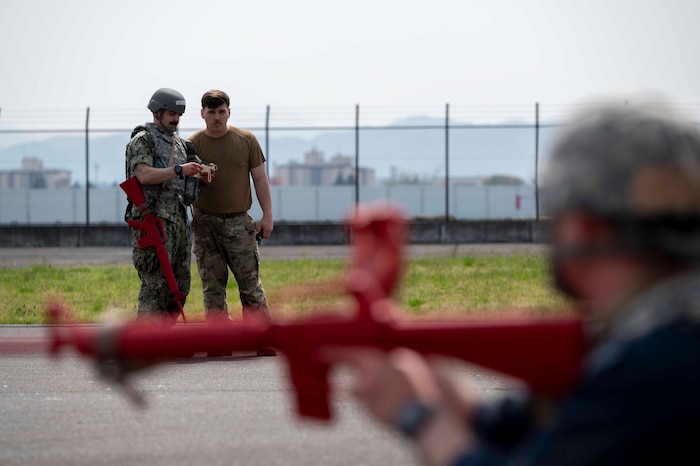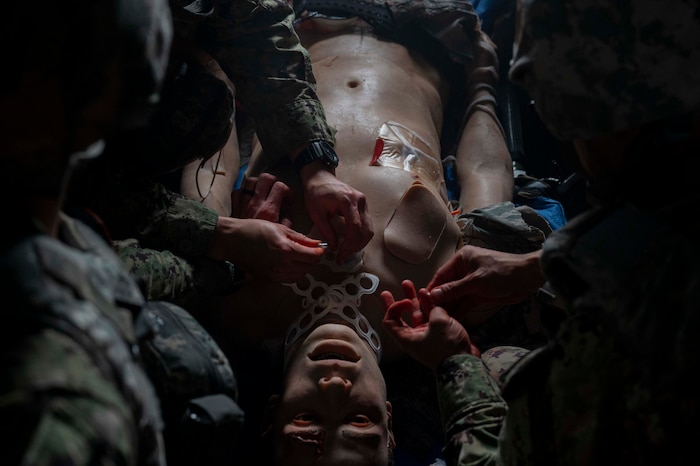YOKOTA AIR BASE, Japan -- The 374th Medical Group hosted Sailors from the U.S. Navy 7th Fleet for two iterations of tactical combat casualty care training at Yokota Air Base, Japan, March 30 - April 4 and April 13 - 18.
Twenty medical professionals participated in a six-day course that included briefings, didactic and hands-on skills training, and culminated with two scenario-based field exercises where they put their newfound knowledge to the test.

374 MDG hosts Navy Corpsman for TCCC training
U.S. Navy Hospitalman Jonathan Vanbuskirk, assigned to the Nimitz-class aircraft carrier USS George Washington (CVN 73), relays information on a radio during a tactical combat casualty care training exercise at Yokota Air Base, Japan, April 17, 2025. Facilities on Yokota have the ability to recreate maritime-specific environments through training elements like smoke effects and low-light conditions, which provide Sailors with realistic, shipboard-relevant casualty care training. (U.S. Air Force photo by Senior Airman Samantha White)
1 of 5

374 MDG hosts Navy Corpsman for TCCC training
A U.S. Navy Hospital Corpsman performs critical medical care on a simulated patient during a tactical combat casualty care training exercise at Yokota Air Base, Japan, April 17, 2025. The TCCC program trains all service members, including medical personnel, to perform medical care in austere conditions and out in the fleet or field. (U.S. Air Force photo by Senior Airman Samantha White)
2 of 5

374 MDG hosts Navy Corpsman for TCCC training
U.S. Navy Hospitalman Jonathan Vanbuskirk, assigned to the Nimitz-class aircraft carrier USS George Washington (CVN 73), speaks to a U.S. Air Force tactical combat casualty care instructor during a TCCC training exercise at Yokota Air Base, Japan, April 17, 2025. The TCCC program at Yokota strengthens combat medical readiness across the Indo-Pacific region by fostering joint-service collaboration and delivering realistic, mission-focused medical training. (U.S. Air Force photo by Senior Airman Samantha White)
3 of 5

374 MDG hosts Navy Corpsman for TCCC training
U.S. Navy Hospital Corpsmen perform critical medical care on a simulated patient during a tactical combat casualty care training exercise at Yokota Air Base, Japan, April 3, 2025. The TCCC program trains all service members, including medical personnel, to perform medical care in austere conditions and out in the fleet or field. (U.S. Air Force photo by Senior Airman Samantha White)
4 of 5

374 MDG hosts Navy Corpsman for TCCC training
U.S. Navy Hospital Corpsmen perform critical medical care on a simulated patient during a tactical combat casualty care training exercise at Yokota Air Base, Japan, April 3, 2025. The training scenarios were tailored to the three phases of tactical combat casualty care: care under fire, tactical field care and tactical evacuation care. (U.S. Air Force photo by Senior Airman Samantha White)
5 of 5
“This training partnership was designed to enhance interoperability through innovative training solutions,” said U.S. Air Force Col. Janice Pecua, 374 MDG chief nursing officer. “As military operations evolve to become increasingly joint and multidomain, the need for training that mirrors the collaborative essence of modern warfare has reached a critical juncture.”
Facilities on Yokota have the ability to recreate maritime-specific environments through training elements like smoke effects and low-light conditions, which provide Sailors with realistic, shipboard-relevant casualty care training.
“Leveraging Yokota Air Force Base’s TCCC training assets presents a strategic, cost-effective and joint force integrated solution for Naval Forces in Japan,” said U.S. Navy Master Chief Hospital Corpsman Mercedes Sawin, assigned to U.S. 7th Fleet, medical senior enlisted leader. “Beyond cost savings, this initiative strengthens joint force integration by leveraging Air Force training infrastructure to enhance interoperability between services.”
As the Joint Trauma System and Defense Health Agency-approved prehospital battlefield medicine readiness training platform, TCCC allows service-specific instructional design to enhance the curriculum based on specific service needs, mission needs, or foundational skills of medics.
“The curriculum is organized to train and equip medics with the vital skill sets and adaptability they need to thrive in fast-paced and unpredictable combat situations, especially here in the [Pacific region], whether ashore, at sea, or in contested littorals,” said U.S. Air Force Maj. Moshood Yinusa, 374 MDG TCCC program manager.
The TCCC team ensures participants are well-prepared for any situation by integrating tactical principles and realistic scenarios that closely reflect the challenges faced in combat.
“Working together with the Air Force instructors gave us a chance to see how our medical operations align across services, which is critical for joint missions, but rare to experience in our usual shipboard environments,” said U.S. Navy Chief Hospital Corpsman Uche Nzegwu, assigned to the Nimitz-class aircraft carrier USS George Washington (CVN 73). “It’s the kind of exposure that makes us better prepared for real-world scenarios overall.”
The TCCC program at the 374 MDG strengthens combat medical readiness across the Indo-Pacific region by fostering joint-service collaboration and delivering realistic, mission-focused medical training. Through continued partnerships similar to these TCCC iterations, U.S. forces remain postured and ready for real-world contingencies.